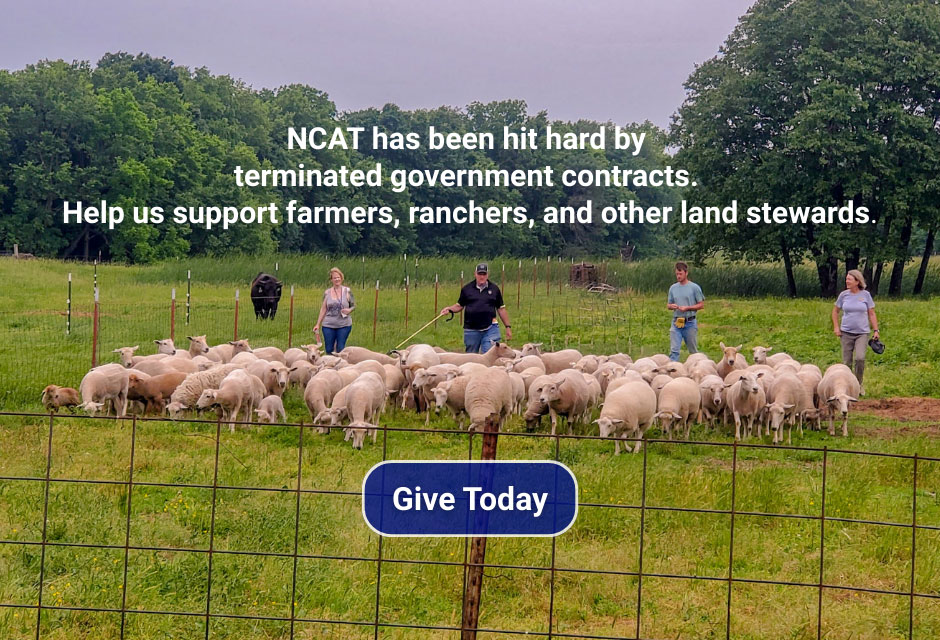Living Lawn Mowers in a World of Mowing Madness
 Print This Post
Print This Post
By Danielle Crocker, NCAT Sustainable Agriculture Specialist
Mowing lawns is a common activity in the United States due to factors like suburbanization, homeownership trends, and a cultural emphasis on well-maintained yards. A well-clipped yard with stripes is often associated with the American Dream. Mowing has become an American pastime. I won’t deny how attractive a green, shining sea of grass can be. But I’ve always wondered, isn’t there anything better you could do with that space?
I get it: farming isn’t for everyone. But mowing isn’t for everyone, either. I knew it wasn’t for me in 2015. It all began with the purchase of a 20-acre lawn that conveniently came with a home. My partner at the time had a different idea of how to “manage” our wide-open, green space. That idea included keeping a short leash on our grass. I hated mowing. I despised mowing. The dust, the heat, the noise—it’s a never-ending summer activity. Mowing is a weekly or bi-weekly event for a solid six months here in western North Carolina. It was August when we purchased this plot. By September, I made some radical changes to our mowing madness.
In the beginning, I just popped up some electric fencing around an old lean-to and bought some sheep. I started with five babydoll sheep, a small breed that is very cute and very fleecy, from head to toe. I quickly learned they were too high-maintenance for me. I bred those and sold the flock. I then tried a flock of seven Shropshire sheep. I enjoyed the Shropshire, but perhaps they were a bit too large for me. I bred those and sold the flock. By this time, I decided wool sheep were too much maintenance for North Carolina. So, I moved on to Katahdin sheep. These sheep were the goldilocks of sheep for me. They were larger than baby dolls and smaller than Shropshire. Best of all, Katahdin’s, being hair sheep, did not require shearing. They grow a woolly coat that sheds from spring into summer. This makes them hardy to cold and heat without the maintenance of shearing. But then one day, I made an impulse buy, which I do not recommend. I found two East Friesian sheep. East Friesian is a dual-purpose sheep best known for dairy production. However, they can also be used for wool and meat. But alas, I was back to shearing this friendly, fleecy, dairy, meat sheep. I was fed up with myself and my sheepy adventures. I wanted natural lawn mowers, that could also provide income and fill my fridge when necessary. That’s when I made the giant leap to dairy goats.
I purchased three floppy-eared Nubian does. They were so full of life and silly goat shenanigans. Besides having to erect a solid, woven wire fence, I found them to be low maintenance. Not everyone will agree. But since moving on to dairy goats in 2017, I haven’t looked back. Although, in the beginning, I did look around for my goats a time or two. Goats are notorious for finding a way out of a fence. I once heard someone say: “What’s the best fence for goats? A fence that can hold water is a fence that can hold goats.” I found a well-constructed woven wire fence with proper supports can and will hold goats.
What worked for me, might not work for you. Looking back, Katahdin sheep were probably the best choice for me. Mostly due to the abundance of grass I had. It’s just not as conducive to goats. That’s because goats are known as browsers more so than grazers, meaning they prefer to eat woody shrubs, bushes, and tree leaves rather than grasses. This allows goats to obtain a broader spectrum of nutrients from different types of vegetation. However, managed pastures with legumes, high-quality hay, and minerals can help keep goats healthy.
Over time, I’ve added multiple paddocks to limit overgrazing of desired species, reduce parasites, and boost soil health. Does my lawn look as neat as it would with the use of a motorized mower? Absolutely not. But I’m here to tell you: I prefer the personality of goats more than both sheep and lawn mowers. Goats might not realistically make my life easier than just mowing. But they make me more money than mowing or sheep ever did. Plus, they are a lot more fun to manage.
This novel approach to landscaping isn’t just a whimsical trend. It’s a sustainable solution that combines charm with environmental factors. As these creatures munch through fields, they fertilize the soil and create a harmonious cycle of nutrient replenishment. It’s not merely a shift in aesthetics; it’s a conscious effort to be kinder to yourself and the planet.
Related ATTRA Resources:
Sheep and Goats: Frequently Asked Questions
Getting Started with Livestock
An Illustrated Guide to Sheep and Goat Production
Small-Scale Livestock Production
Episode 179. Getting Started in Livestock, Part 1
Episode 228. A Closer Look at Hair Sheep
This blog is produced by the National Center for Appropriate Technology through the ATTRA Sustainable Agriculture program, under a cooperative agreement with USDA Rural Development. ATTRA.NCAT.ORG.

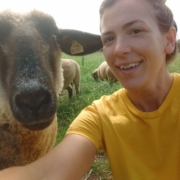
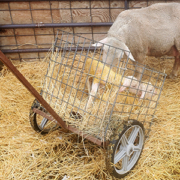
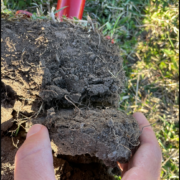





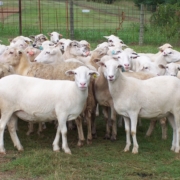
 USDA Photo by Lance Cheung.
USDA Photo by Lance Cheung.
